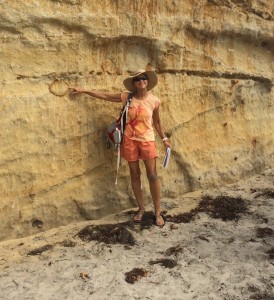 Vein Structures and Intrastratal Microfractured Zones Interpreted in Cores of Late Miocene Diatomite, Midway Sunset Field, CA
Vein Structures and Intrastratal Microfractured Zones Interpreted in Cores of Late Miocene Diatomite, Midway Sunset Field, CA
Bonnie Bloeser
Sr. Staff Geologist Aera Energy (retired)
Wednesday, October 7th, 2015
CSL 422 – 1 pm
Abstact
Silty diatomaceous mudrock from the Belridge Diatomite Member, Reef Ridge Shale, Monterey Formation preserve small-scale veins and microfaults. This study compares vein, fracture, and fault geometry and mineralogy from four whole cores of argillaceous diatomite in Midway Sunset Field to what has been described in both outcrop and modern offshore diatomaceous sediments. Thin section petrography using both standard and reflected ultraviolet light was combined with scanning electron microscopy (SEM) on standard and argon ion-milled samples to document the microfabrics, fracture styles, mineralogy and paragenesis of events. Formation and evolution of vein structures as fluid escape features, and microfault development at vein sites, is reported in diatomaceous muds cored from active margins during the Ocean Drilling Program and Deep Sea Drilling Project. A diffuse type of vein structure observed in the core of Miocene diatomite compares well with what are termed ‘ghost veins’ in modern offshore Peru sediments, which develop preferentially in more diatom rich laminae. Preservation of primary vein networks, grain alignment, and fill mineralogy observed in the cores of Miocene diatomite are relict signatures of fluid expulsion that occurred early in the unconsolidated diatom ooze lamina within diatomaceous muds. The sigmoidal en echelon tension gash fracture sets are recognized in whole core by their distinct geometry, darker color, and reduced porosity and permeability relative to the surrounding matrix. They form subparallel en-echelon arrays whose terminal projections are aligned along common bedding planes or other distinct geomechanical boundaries. In SEM, the material within tension gash structures, relative to the surrounding diatomite, is composed of highly comminuted diatom fragments and minor clay and organic material. Multiple crosscutting sets of ‘ghost veins’ and en echelon structures are observed. Both features are observed in finely laminated diatomites as well as in more thickly bedded intervals and their manifestations vary with the clay content of the bed. Vein structures, fracture styles and their relationship from observations in the cores of Miocene diatomite of the Midway Sunset Field supports outcrop- and modern sediment-based interpretations that syn-sedimentary to early post-depositional downslope movement of highly porous and low permeability, organic-rich sediments drives their formation.
 B. Bloeser, M. Nelis, Vein Structures and Intrastratal Microfractured Zones Interpreted in Cores of Late Miocene Diatomite, Midway Sunset Field, CA, 11 August 2014, Search and Discovery Article #20263(2014)
B. Bloeser, M. Nelis, Vein Structures and Intrastratal Microfractured Zones Interpreted in Cores of Late Miocene Diatomite, Midway Sunset Field, CA, 11 August 2014, Search and Discovery Article #20263(2014)

